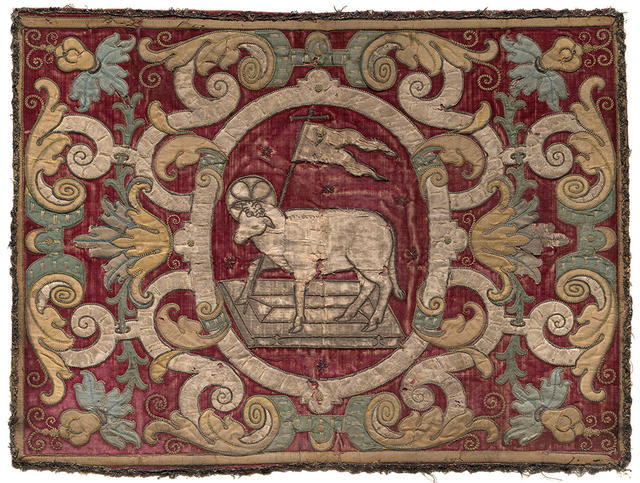Artist Unknown
Dalmatic Panel, Agnus Dei [Lamb of God]
- 1600-c. 1630
- Appliqué with silver thread
- Purchased 1972
- 370 x 520mm
- 72/24
Location: Burdon Family Gallery
Tags: animals, Christianity, flags, flowers (plants), Judaism, patterns (design elements), plants (living organisms), red (color), religious art, sheep, stylization
This embroidered panel is from a dalmatic, a deacon’s vestment worn during the Mass. Panels in this style featured on dalmatics in Spain and Italy from the late sixteenth century on. This one represents Christ as the resurrected Lamb of God, standing triumphant over the grave and death with a victory pennant on a cross.
(Out of Time, 23 September 2023 – 28 April 2024)
Exhibition History
One of the oldest works in the Gallery's small textile collection is The Pascal Lamb, made by an unknown artist, which has been dated to c.1660 AD. This appliqué work (a technique where shapes are cut from one piece of fabric and applied to another) combines silver thread, satin fabric and a red velvet background to depict a common heraldic subject, a white lamb carrying a banner. The lamb is a familiar symbol in Christian art, where it is the emblem of the Redeemer and also the attribute of several saints, including St. Agnes, St. Catherine and St. John the Baptist. The subject of this particular work, the Pascal (or Paschal) Lamb, is the animal sacrificed and eaten at the Jewish Passover, a festival commemorating the liberation of Israelites from Egyptian bondage. For Christians, Jesus Christ is identified with the Paschal Lamb because the meal which became the Last Supper began as a Passover feast. Christ was then referred to as the Lamb of God: John 1:29: "Behold the Lamb of God, which taketh away the sin of the world", 1 Corinthians 5:7: "For even Christ our passover is sacrificed for us".
The Lamb in this work is shown passant, that is, walking and looking to the dexter side (the right side of the composition, which is the viewer's left) with three feet on the ground and one raised. With this raised hoof, the Lamb supports the banner of St George, the patron saint of England, whose legendary slaying of a dragon symbolised the triumph of Christianity over evil. The Pascal Lamb was purchased in 1972 from an Auckland antique dealer by Brian Muir (Director of the Gallery between 1969 and 1978) as part of a strategy (common in museological practice at that time) to contextualise the collection by augmenting historical artworks with period furniture and other domestic items. The Lamb has not survived its long period of existence without accumulating several marks of age, as the velvet background has lost much of its pile and colour intensity and the satin fabric is worn in places, revealing a coarse plain-weave support fabric behind. A slight crease down the centre of the fabric suggests that The Lamb spent at least some of its history folded in half.
(Label date unknown)
![Andreas Cellarius Hypothesis Ptolemaica Sive Communis Planetarum Motus Per Eccentricos Et Epicyclos Demonstrans [The Ptolemaic Hypothesis or Common Representation Demonstrating the Planetary Motions through Eccentrics and Epicycles] 1661. Hand-coloured engraving. Collection of Christchurch Art Gallery Te Puna o Waiwhetū, William A. Sutton bequest, 2000](/media/cache/05/97/05970cdff0f6b3264062d69bf2aa90f5.jpg)

